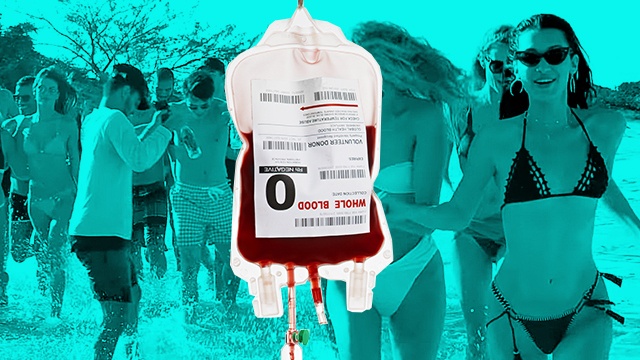The key to a longer and healthier life may be closer to us than we thought. It’s location? Our blood; but more specifically, the blood of the young.
Earlier this year, the US medical start-up Ambrosia launched a blood transfusion service where the plasma of 16 to 25-year olds is intravenously injected into a client’s circulatory system, which claims to reverse the aging process. Just one session “dramatically improves people’s appearance, their memory and their strength”, says Jesse Karmazin, Stanford medical graduate and founder of Ambrosia. However, the results of their self-funded clinical trial are yet to be released, and with a starting price of $8,000 for 1 litre of blood plasma, the company has been heavily criticised.
Karmazin first thought of the idea of young blood transfusions after reading into anti-aging parabiosis studies. Parabiosis is where the skin and vasculature of two living animals – usually mice – are cut and sewn together, leading to a conjoined circulatory system. In anti-aging studies, an old and young mouse are surgically attached, which exposes the old partner to factors in the blood of the young.
The first age-related parabiosis study in 1972, conducted by researchers at the University of California using pairs with old and young rats, reported that older partners lived an average of 4.5 months longer than controls. This is equivalent to 22 human years.
In the following decades, the rejuvenating effects of young blood parabiosis in older mice were explored in the heart, brain and other tissues. The results showed evidence of increased cell regeneration in almost all examined organs, which made old mice healthier, stronger and enhanced their cognition.
In a 2011 study published in Nature, there was a 20 to 50% increase in the neuroplasticity network of older mice. “There is an increased activity of the synapses, the connections between neurons, and there are more genes expressed that are known to be involved in the formation of new memories”, says Tony Wyss-Coray, lead researcher of the study and co-director of the Alzheimer’s research centre at Stanford University Medical School. Intriguingly, their conjoined younger partners had a decrease in synaptic plasticity, which correlated with a reduction in their spatial learning and memory. Alongside young blood factors that combat aging, “there are old blood factors that can accelerate aging”, he says. Motivated by his results, Coray co-founded Alkahest in September 2014, a biotech start-up aiming to treat Alzheimer’s with young blood plasma.
As previously mentioned, Karmazin was inspired by these anti-aging parabiosis studies, which led to the conception of Ambrosia. Between June 2016 and January 2018,they completed the US’ first clinical trial to observe the effects of young blood plasma transfusions in 104 people over the age of 35. “It’s like plastic surgery from the inside out”, says Karmazin. However, the trial was highly criticised as participants had to pay $8,000 to join, and there were no control variables. “There’s just no clinical evidence [that the treatment will be beneficial], and you’re basically abusing people’s trust and the public excitement around this”, says Coray, suggesting that this could tarnish future blood transfusion research.
Out of the 104 participants, only one man spoke to the press about his experience. He was one of the first patients to receive the treatment and suggested that he received “more blood plasma than anyone else in the world” and added that he wanted to “just get 10 more healthy years of living”. Karmazin told the media that he was the “most excited person about this treatment”.
In February 2018, the man died after going into cardiac arrest at the age of 65.
Karmazin stated that there were no deaths during, or after the trial related to the blood transfusion treatment. It has been over a year since the trial concluded, however, the results are still unreleased. Unsurprisingly, in late February 2019, Ambrosia were forced to put their operations on hold by the FDA due to a lack of clinical evidence to support their claims.
“People want to believe that young blood restores youth, even though we don’t have evidence that it works in humans and we don’t understand the mechanism of how mice look younger”, says Coray. It is early days, but young blood could still have the potential to aid future treatments of diseases associated with old age, such as Alzheimer’s. Thus, more rigorous research is needed before young blood is hailed as the next fad diet in our potentially dystopian future.
image source:
https://uproxx.com/life/blood-transfusion-young-blood-ambrosia/

